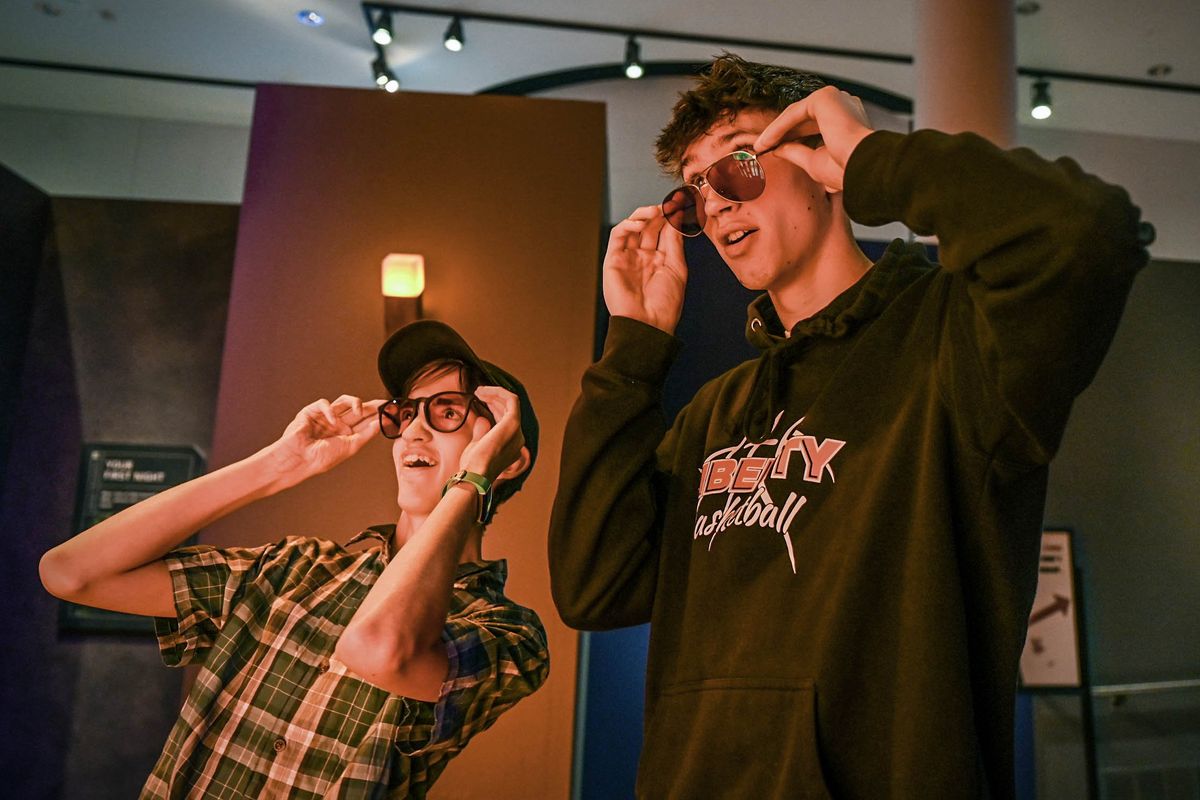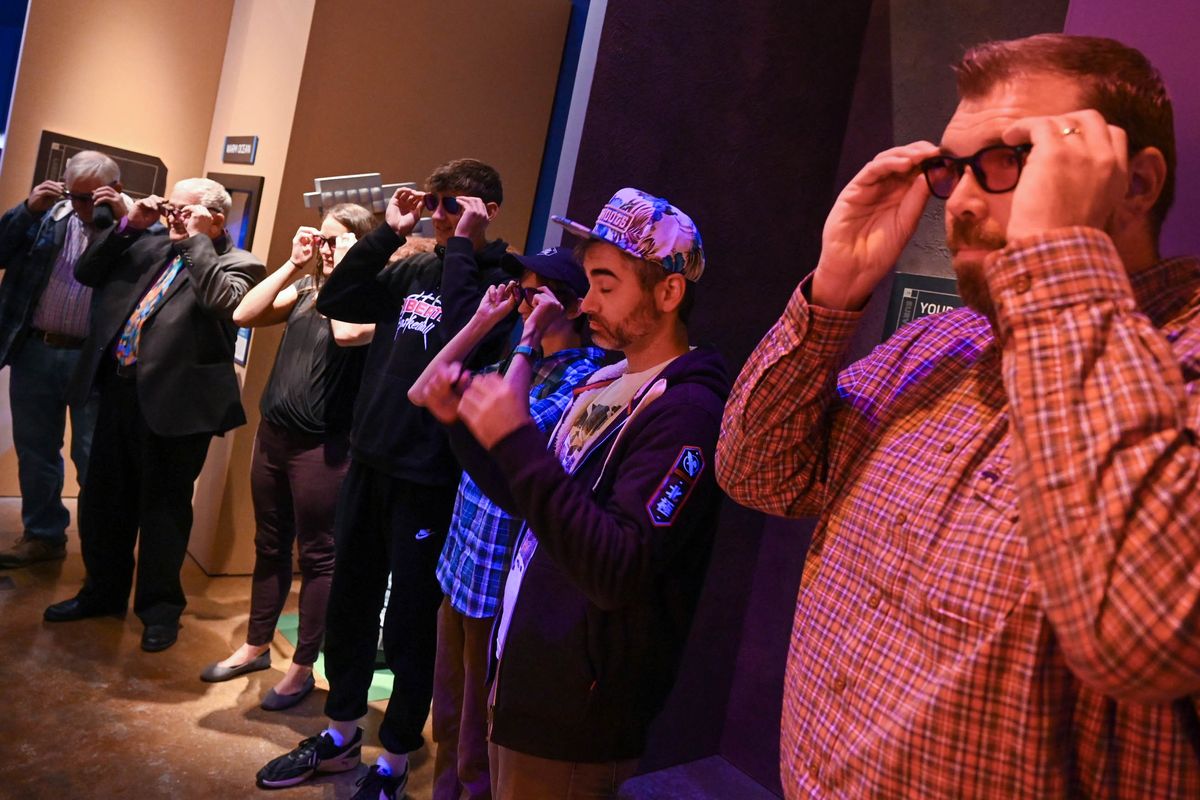Specialized glasses now at the MAC bring out the missing hues for color blind visitors

Joshua Domrese couldn’t stop grinning as he spied a range of red hues in a lighted Minecraft lava display.
He’s played the game before, but Domrese had never seen the subtle hue differences until Thursday, when he got a glimpse through new lenses.
For the first time, the Lewis and Clark student donned specialized glasses made by EnChroma, a Berkeley, California, company that makes them with engineered optical filters to expand a range in red and green colors that color-blind people typically can’t see. Without the glasses, the lava was orange and “kind of red,” he said.
“This is red, orange, yellow,” added Domrese, 17. “It’s a bunch of subtle things that I didn’t realize before. It’s a lot richer – a lot of the things – deeper and more interesting. There are intricacies and depth I didn’t know existed.”
The Northwest Museum of Arts and Culture invited Domrese and eight other Spokane-area residents who are color blind – including his twin brother, Thomas – to use the EnChroma glasses to view its video game-inspired “Minecraft: the Exhibition” and other displays. The group got to keep the glasses donated by EnChroma, which has a program for gifting the shades to museums and attractions globally.
This week, the MAC became the first Spokane museum now offering four of the specialty glasses – also donated from EnChroma – so that color blind visitors can borrow them to view displays.
Thomas Domrese, a Liberty High School student, joined his brother in marveling over the “sandbox” world of Minecraft at the museum. Now, they want to go to Disneyland with the glasses, and they planned to watch the day’s sunset.
“There is a lot of color I’ve not noticed before,” Thomas Domrese said about one display. “On the corners of that shirt over there, I’d not noticed that blue before; I thought it was one solid color.”
Being color blind is an inability to see the difference between certain colors, most commonly as a deficiency causing an inability to see some shades of red and green. Another type makes blue and yellow look the same.

An estimated 350 million people worldwide are red-green color blind, or one in 12 men and one in 200 women. It’s genetic, and parents pass down the genes for red-green color vision deficiency through the X chromosome, according to the National Eye Institute. It says the blue-yellow color vision deficiency involves other chromosomes, so that one affects men and women equally.
Members of the group who visited the MAC included a psychiatrist, carpenter, pharmacist and retired second-grade teacher.
Denise Pounds, a family medicine doctor, was the only woman among the EnChroma-wearers. She sees patients and works with medical residents at Spokane Teaching Health Clinic. Now 41, she said her first clue was in college, when someone asked her to do color-wheel testing.
She joked that before that, she’d compensated but mostly argued about what certain hues really were. On the job, Pounds said she occasionally has asked for a colleague’s eye to confirm a rash, or she uses other physical clues, if she sees a spot as a normal skin tone.
“For me, it’s mostly differentiating closer colors – so blues, purples, grays, navy, black, different shades of orange-yellow,” Pounds said.
In front of a museum image that had a sunset, with the glasses on, she did see different hues.
“I can appreciate more color; it’s deeper and richer,” she said. “What I’m noticing is enhanced – more of a deep, dusty pink-red, when I would have said maybe there were purple hues and blue-ish color.”
Pounds said she’s eager to share the glasses with her sons, 6 and 11, who are color blind. Another MAC image had dark-to-light greens.
“I didn’t realize there was a color differentiation, so it’s lighter green at the top and then darker green,” she said. “I would have called those a uniformed stick of green.”
Dylan Fiorino, 19, who is training to be a machinist, said he couldn’t wait to go see a sunset and car show. Before, vehicle colors seemed mostly the same, “like gray, black, green,” he said.
“I can’t see anything with red in it, so all the colors I’m seeing now are completely new to me. I’m almost 20, so this is kind of big deal for me.
“Think about what you can do. You can go play all your favorite video games and see your favorite movies again, in color. It’s going to be fantastic.”
EnChroma’s chief science officer Don McPherson first discovered color-blind benefits in lenses while working to create protective eye gear for surgeons who use lasers in operations. In 2010, during an ultimate Frisbee game, a color blind teammate asked to try on McPherson’s invention, a recent Washington Post article described. That player for the first time could see the orange boundary cones and green field.
EnChroma glasses entered the market in 2010, when the glasses at that time cost $700, said Kent Streeb, the company’s vice president of communications. Today, EnChroma glasses range from $189 to $349, he said.
He said the glasses improve depth and detail for color-blind people.
“The critical element is that they give the color blind the red and green they need, but not at the expense of distorting or tinting the colors they already see just fine.”